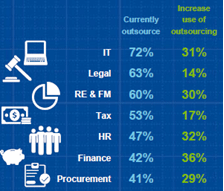We are in the last quarter of 2017 and as per the substantial shift in the preceding year; we can see the impact on outsourcing industry the approaching year. One can witness a significant rise in outsourcing of software services. As per the reports by Forrester Research (2016), it was more than 440 billion U.S. dollars the global business and government spent on hardware maintenance and IT outsourcing.
Enterprises around the world are not finding it taboo, outsourcing the development tasks. So, the off-shore service providing agencies meanwhile should prepare themselves with new trends that will define the future of IT outsourcing industry.
(deloitte.com)
The outsourcing landscape is clearly seeing a paradigm shift. And nothing has changed, whether it is customer service operation, website development, or software development, clients will ask more and expect their off-shore agencies to design or provide what they actually expect.
The paradigm shift is about how companies have increased their interests in outsourcing, inclusive of their development tasks. Yes, companies don’t shy anymore to outsource business-critical operations and they will do more in future.
When we speak of future let’s see what our outsourcing agencies have in their hands.
Learning about Top 5 Outsourcing Trends for 2018
TREND 1: Rapid Application Development
First, let’s understand RAD.
An alternative to typical waterfall model for software development, RAD emphasizes more on the process, lesson planning for faster product delivery. The method focuses on agile development for quick delivery of applications. To be more specific, the benefits are huge and the methods involve rapid prototyping, virtualization of system related routines, the use of case tools, and including the usability of GUI designs.
Every organization would adopt RAD for development, and if you provide software development outsourcing services, then it’s time you make yourself aware of this robust development model.
Because it’s not like every organization can afford to hire dedicated development team with expertise in this approach. So it’s time you cash-in on the opportunity.
TREND 2: Application Development
How to gain a competitive advantage over global brands?
This is a common question that pops into every entrepreneur’s mind.
Also, as per reports by statista.com, by 2020 mobile applications are predicted to generate around 189 billion U.S. dollars in revenues via app stores and in-app advertising.
Application for a business is a huge requirement, but not every business can afford to have both the product and developers under one roof as they find it too onerous for their capital. Hiring cheap application developers, as in amateurs will also be expensive, so the best solution is they outsource their application development tasks to professional agencies.

Again one more opportunity is companies don’t have any choice but to adopt the mobile-first approach policy and the most challenging part is not everyone can have a dedicated in-house team.
It’s a win-win situation for companies if they outsource their application development, they can together address the issues concerning hiring resources and meeting large expenses.
TREND 3: Game Development
Software developers apart from preparing themselves for the big data should also know a thing or two about gaming.
No, they will not play games but will develop it.
Yes, as per the Global Games Market Report released by Newzoo, it is expected that by 2020, the game market would generate revenue of $128.5 billion. While mobile gaming is representing half of the chunk of the gaming market, PC and console gaming is taking the corner.
It’s a rapidly developing market and companies who want to let themselves into the global race should either hire professionals or outsource to agencies that could provide one.
TREND 4: Cloud Integration
Every organization is using cloud technology. Even though maximum percentage is using the public cloud for their business operations, there will be at least some applications where they would prefer hosting on a private cloud.
Having private cloud means huge investment and high maintenance.
Cloud technology presents a lot of opportunities, the beauty of integrating and investing in SaaS business can access and manage the huge amount of data under a single platform. But again there are lots of challenges they have to equally address. For instance, apart from running their core business operations, they have to upgrade the software as and when it is required.
And security, it’s not easy, so they have to invest additionally on security services for cloud management.
To speak in few words, in-house cloud integration is not a good option if your business is running on a thin budget.
Outsourcing cloud integration will keep enterprises away from additional costs and other operational complexities.
TREND 5: Machine Learning
While outsourcing industry is bracing for the AI impact, investments are on and everyone, trust me, every single person running a business is betting on AI.
Machine learning is a subset of AI. AI allows making calculated business decisions and machine learning will help to do that.
So why should businesses outsource machine learning?
Machine learning is still new and people need professional programmers who can teach machines around the huge set of data and variable patterns. Doing so, they can make smart business decisions in the future, for the better future.
Most of the companies are providing machine learning as a service. You may not find plenty, but you will definitely find it easier to pick the right one.



